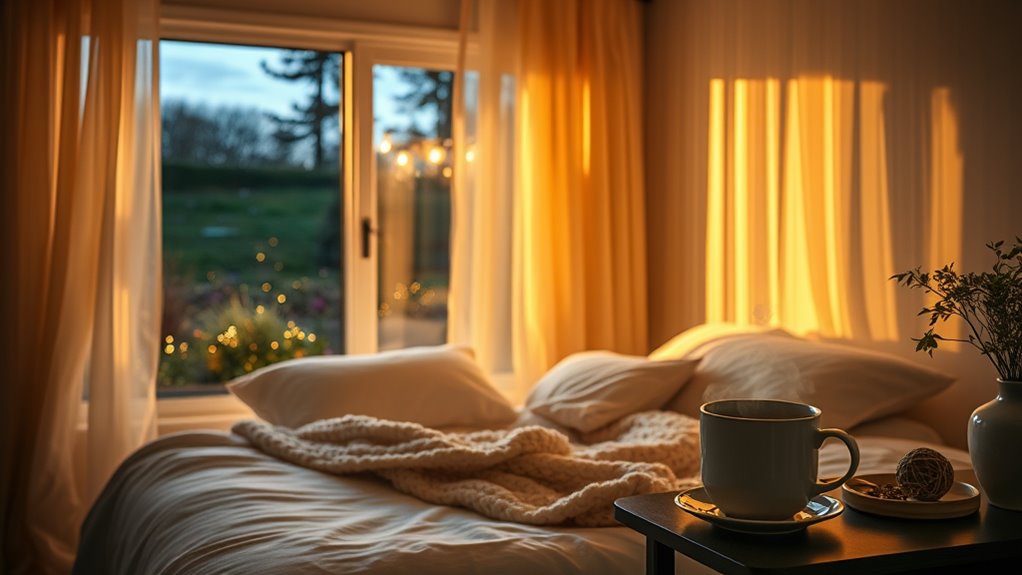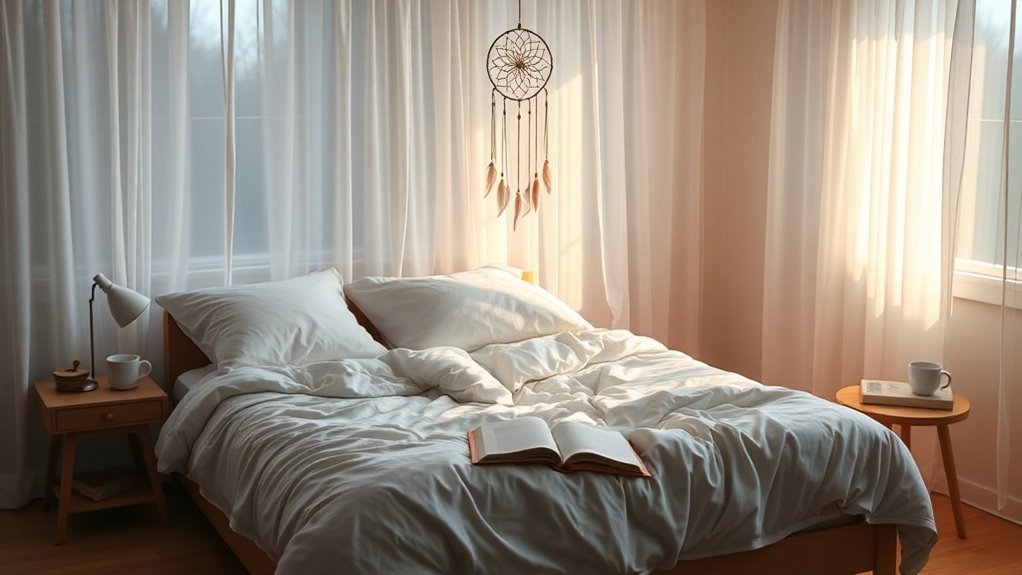End Your Day With This Peaceful Sleep Visualization
As your day winds down, it’s easy to carry the weight of daily stresses into the night. But what if you could gently release those burdens and embrace a sense of calm? Visualization can be a powerful tool for easing your mind and body, helping you transition into restful slumber. Picture yourself on a serene beach, letting the soft waves wash away your worries. Let’s explore how this simple practice can transform your nighttime routine.
Key Takeaways
- Begin by dimming the lights and creating a calming atmosphere to signal your body it’s time to unwind.
- Close your eyes, take deep breaths, and visualize a serene landscape, like a tranquil beach or peaceful forest.
- Focus on the soothing details of your chosen scene, such as the sound of waves or rustling leaves, to promote relaxation.
- Let go of daily stress and tension, immersing yourself in the sensations of warmth and gentle breezes from your visualization.
- Incorporate calming elements like essential oils and soft sounds to enhance your sleep environment and support restful sleep.
The Importance of Visualization for Sleep
Have you ever found yourself lying awake at night, your mind racing with thoughts? It’s frustrating, isn’t it? That’s where a sleep visualization exercise comes in.
By picturing calming scenes, you can gently guide your mind away from stress and into a restful state.
Visualization not only reduces anxiety but also helps your body relax, making it easier to fall asleep.
Visualization eases anxiety and promotes relaxation, paving the way for a smoother path to sleep.
Imagine a serene beach or a quiet forest; immersing yourself in these images can create a peaceful mental space.
Embracing this technique can transform your nights, leading to deeper, more restorative sleep, and helping you wake up refreshed. Incorporating visualization techniques into your nightly routine can significantly enhance your ability to unwind and drift off peacefully.
Preparing Your Mind and Body
As you prepare your mind and body for sleep, creating a calming atmosphere is essential. Start by dimming the lights, reducing noise, and ensuring a comfortable temperature. Consider these helpful elements to enhance your bedtime routine:
| Element | Tips | Benefits |
|—————-|——————————-|——————————–|
| Lighting | Use soft, warm lights | Promotes relaxation |
| Aromatherapy | Diffuse calming essential oils | Reduces stress and anxiety |
| Music/White Noise | Play gentle sounds | Masks distractions, soothes |
| Mindfulness | Practice deep breathing | Calms the mind, eases tension |
Embrace these elements for a peaceful transition into sleep. Incorporating nighttime visualization techniques can further promote relaxation and enhance your overall well-being.
Guided Visualization Steps
Once you’ve set the stage for relaxation, guided visualization can be a powerful tool to ease your mind into a peaceful state.
Guided visualization is an effective way to transition your mind into a state of relaxation and peace.
Close your eyes and take a deep breath, envisioning a serene landscape—perhaps a calm beach or a quiet forest.
Picture the details: the sound of waves or rustling leaves.
As you immerse yourself in this scene, let go of any tension.
Focus on the sensations, like the warmth of the sun or the gentle breeze.
Allow your thoughts to drift, surrendering to the tranquility.
With each breath, feel yourself sinking deeper into this peaceful visualization, preparing for restful sleep. Engaging in sleep visualizations can significantly enhance your ability to achieve deep sleep instantly.
Enhancing Your Sleep Environment
How can you create an environment that fosters restful sleep?
Start by dimming the lights and reducing noise.
Consider using blackout curtains to block out disturbances, and keep your room cool and comfortable.
Aromatherapy can also help; try lavender or chamomile to soothe your senses.
Clear away clutter, as a tidy space promotes relaxation.
Invest in a quality mattress and soft bedding to enhance your comfort.
Lastly, limit screen time before bed to reduce blue light exposure, allowing your mind to unwind. Additionally, incorporating simple visualization techniques can help further calm your mind and prepare you for a restful night’s sleep.
Incorporating Visualization Into Your Nightly Routine
Embrace the power of visualization to enhance your nightly routine and invite tranquility into your mind. Start by finding a comfortable position, close your eyes, and take deep breaths. Picture serene landscapes or calming scenes that resonate with you. Gradually let go of the day’s stress, focusing on the soothing imagery. Incorporating transformative sleep visualizations into this practice can transform your sleep experience into a restorative journey.
| Step | Action |
|—————|———————————-|
| 1. | Find a quiet space |
| 2. | Take deep breaths |
| 3. | Visualize a peaceful scene |
| 4. | Let go of daily stress




